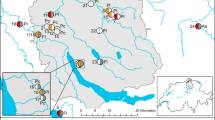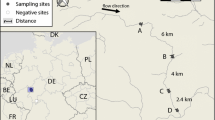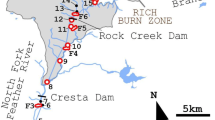Abstract
While environmental DNA (eDNA) approaches have the potential to revolutionize biodiversity research and monitoring, most aquatic biomonitoring and management programs still rely on conventional monitoring methodologies. Here we evaluated the suitability and robustness of an eDNA-based approach for the detection of the crayfish plague agent Aphanomyces astaci and assessed the capacity of this new method as practical tool for bioassessments in freshwater. The approach was examined in three case studies: case study A tested its use as biomonitoring tool to determine the range and density of A. astaci- infected crayfish populations in three different water systems. Case study B focussed on the identification of possible A. astaci infection sources, here an aquafarm. For case study C we assessed a migration front of infected crayfish near a native crayfish area. The eDNA-based detection allowed to infer local patterns and distribution limits of crayfish plague occurrence. Spore estimates in eDNA samples correlated significantly with catch per unit effort values and pathogen loads of captured A. astaci- positive crayfish obtained from trapping in running waters. We also showed that spore concentrations are detectable up to three kilometres downstream from hot spot areas of infected crayfish. By identifying a possible A. astaci entry point and migration front eDNA proved suitable for the detection of A. astaci spores at low population densities and/or pathogen levels of infected crayfish. The study provides conclusive evidence for the suitability of the eDNA approach as a tool for risk assessment and large-scale monitoring of A. astaci for a wide range of practical conservation issues of indigenous crayfish species.





Similar content being viewed by others
References
Adrian-Kalchhauser I, Burkhardt-Holm P (2016) An eDNA assay to monitor a globally invasive fish species from flowing freshwater. PLoS ONE 11:e0147558. https://doi.org/10.1371/journal.pone.0147558
Agersnap S, Larsen WB, Knudsen SW, Strand D, Thomsen PF, Hesselsøe M, Mortensen PB, Vrålstad T, Møller PR (2017) Monitoring of noble, signal and narrow-clawed crayfish using environmental DNA from freshwater samples. PLoS ONE 12:e0179261. https://doi.org/10.1371/journal.pone.0179261
Alderman DJ (1996) Geographical spread of bacterial and fungal diseases of crustaceans. Rev Sci Tech OIE 15:603–632
Alderman DJ, Polglase JL (1988) Pathogens, parasites and commensals. In: Holdich DM, Lowery RS (eds) Freshwater crayfish. Biology, management and exploitation. Croom Helm, London, pp 167–212
Bálint M, Nowak C, Márton O, Pauls S, Wittwer C, Aramayo JL, Schulze A, Chambert T, Cocchiararo B, Jansen M (2018) Accuracy, limitations and cost efficiency of eDNA-based community survey in tropical frogs. Mol Ecol Resour 18:1415–1426. https://doi.org/10.1111/1755-0998.12934
Barnes MA, Turner CR (2016) The ecology of environmental DNA and implications for conservation genetics. Conserv Genet 17:1–17. https://doi.org/10.1007/s10592-015-0775-4
Barnes MA, Turner CR, Jerde CL, Renshaw MA, Chadderton WL, Lodge DM (2014) Environmental conditions influence eDNA persistence in aquatic systems. Environ Sci Technol 48:1819–1827. https://doi.org/10.1021/es404734p
Beakes GW, Honda D, Thines M (2014) Systematics of the Straminipila: Labyrinthulomycota, Hyphochytriomycota, and Oomycota. In: McLaughlin D, Spatafora J (eds) Systematics and evolution. The mycota, vol 7A. Springer, Berlin, pp 39–97
Biggs J, Ewald N, Valentini A, Gaboriaud C, Dejean T, Griffiths RA, Foster J, Wilkinson JW, Arnell A, Brotherton P, Williams P, Dunn F (2015) Using eDNA to develop a national citizen science-based monitoring programme for the great crested newt (Triturus cristatus). Biol Conserv 183:19–28. https://doi.org/10.1016/j.biocon.2014.11.029
Bohmann K, Evans A, Gilbert M, Thomas P, Carvalho GR, Creer S, Knapp M, Yu DW, de Bruyn M (2014) Environmental DNA for wildlife biology and biodiversity monitoring. Trends Ecol Evol 29:358–367. https://doi.org/10.1016/j.tree.2014.04.003
Bubb DH, Thom TJ, Lucas MC (2004) Movement and dispersal of the invasive signal crayfish Pacifastacus leniusculus in upland rivers. Freshwater Biol 49:357–368
Cai W, Ma Z, Yang C, Wang L, Wang W, Zhao G, Geng Y, Yu DW (2017) Using eDNA to detect the distribution and density of invasive crayfish in the Honghe-Hani rice terrace World Heritage site. PLoS ONE 12:e0177724. https://doi.org/10.1371/journal.pone.0177724
Crandall KA (2017a) Astacus astacus (Linnaeus, 1758). World Register of Marine Species. http://www.marinespecies.org/aphia.php?p=taxdetails&id=877649. Accessed 30 January 2018
Crandall KA (2017b) Pacifastacus leniusculus (Dana, 1852). World Register of Marine Species. http://www.marinespecies.org/aphia.php?p=taxdetails&id=885106. Accessed 24 January 2018
DAISIE European Invasive Alien Species Gateway (2008) Aphanomyces astaci. http://www.europe-aliens.org/speciesFactsheet.do?speciesId=50122. Accessed 6 Nov 2017
Dana JD (1852) Conspectus crustaceorum, & c. Conspectus of the Crustacea of the exploring expedition under Capt. C. Wilkes, U.S.N. Macroura. Proc Acad Nat Sci Phila 6:10–28
Deiner K, Altermatt F (2014) Transport distance of invertebrate environmental DNA in a natural river. PLoS ONE 9:e88786. https://doi.org/10.1371/journal.pone.0088786
Deiner K, Walser J-C, Mächler E, Altermatt F (2015) Choice of capture and extraction methods affect detection of freshwater biodiversity from environmental DNA. Biol Conserv 183:53–63. https://doi.org/10.1016/j.biocon.2014.11.018
Dejean T, Valentini A, Duparc A, Pellier-Cuit S, Pompanon F, Taberlet P, Miaud C (2011) Persistence of Environmental DNA in Freshwater Ecosystems. Plos One 6:e23398. https://doi.org/10.1371/journal.pone.0023398
Dejean T, Valentini A, Miquel C, Taberlet P, Bellemain E, Miaud C (2012) Improved detection of an alien invasive species through environmental DNA barcoding: the example of the American bullfrog Lithobates catesbeianus. J Appl Ecol 49:953–959. https://doi.org/10.1111/j.1365-2664.2012.02171.x
Dougherty MM, Larson ER, Renshaw MA, Gantz CA, Egan SP, Erickson DM, Lodge DM (2016) Environmental DNA (eDNA) detects the invasive rusty crayfish Orconectes rusticus at low abundances. J Appl Ecol 53:722–732. https://doi.org/10.1111/1365-2664.12621
Dunn N, Priestley V, Herraiz A, Arnold R, Savolainen V (2017) Behavior and season affect crayfish detection and density inference using environmental DNA. Ecol Evol 7:7777–7785. https://doi.org/10.1002/ece3.3316
Edsman L, Füreder L, Gherardi F, Souty-Grosset C (2010) Astacus astacus. The IUCN Red List of Threatened Species 2010: e.T2191A9338388. Accessed 16 Aug 2018
Evans LH, Edgerton BF (2002) Pathogens, parasites and commensals. In: Holdich DM (ed) Biology of freshwater crayfish. Blackwell Science Ltd, Oxford, pp 377–438
Ficetola GF, Miaud C, Pompanon F, Taberlet P (2008) Species detection using environmental DNA from water samples. Biol Lett 4:423–425. https://doi.org/10.1098/rsbl.2008.0118
Fukumoto S, Ushimaru A, Minamoto T, Crispo E (2015) A basin-scale application of environmental DNA assessment for rare endemic species and closely related exotic species in rivers. A case study of giant salamanders in Japan. J Appl Ecol 52:358–365. https://doi.org/10.1111/1365-2664.12392
Geerts AN, Boets P, Van den Heede S, Goethals P, Van der Heyden D (2018) A search for standardized protocols to detect alien invasive crayfish based on environmental DNA (eDNA). A lab and field evaluation. Ecol Ind 84:564–572. https://doi.org/10.1016/j.ecolind.2017.08.068
Gherardi F, Aquiloni L, Diéguez-Uribeondo J, Tricarico E (2011) Managing invasive crayfish. Is there a hope? Aquat Sci 73:185–200. https://doi.org/10.1007/s00027-011-0181-z
Goldberg CS, Pilliod DS, Arkle RS, Waits LP (2011) Molecular detection of vertebrates in stream water: a demonstration using Rocky Mountain tailed frogs and Idaho giant salamanders. PLoS ONE 6:e22746. https://doi.org/10.1371/journal.pone.0022746
Goldberg CS, Turner DR, Deiner K, Klymus KE, Thomsen PF, Murphy MA, Spear SF, McKee A, Oyler-McCance SJ, Cornman RS, Laramie MB, Mahon AR, Lance RF, Pilliod DS, Strickler KM, Waits LP, Fremier AK, Takahara T, Herder JE, Taberlet P, Gilbert M (2016) Critical considerations for the application of environmental DNA methods to detect aquatic species. Methods Ecol Evol 7:1299–1307. https://doi.org/10.1111/2041-210X.12595
Hogger JB (1988) Ecology, population biology and behaviour. In: Holdich DM, Lowery RS (eds) Freshwater crayfish. Biology, management and exploitation. Croom Helm, London, pp 114–144
Holdich DM, Reynolds JD, Souty-Grosset C, Sibley PJ (2009) A review of the ever increasing threat to European crayfish from non-indigenous crayfish species. Knowl Managt Aquatic Ecosyst 394–395:11. https://doi.org/10.1051/kmae/2009025
Huver JR, Koprivnikar J, Johnson PTJ, Whyard S (2015) Development and application of an eDNA method to detectand quantify a pathogenic parasite in aquatic ecosystems. Ecol Appl 25:991–1002. https://doi.org/10.1890/14-1530.1
Jane SF, Wilcox TM, McKelvey KS, Young MK, Schwartz MK, Lowe WH, Letcher BH, Whiteley AR (2015) Distance, flow and PCR inhibition: eDNA dynamics in two headwater streams. Mol Ecol Resour 15:216–227. https://doi.org/10.1111/1755-0998.12285
Jerde CL, Mahon AR, Chadderton WL, Lodge DM (2011) “Sight-unseen” detection of rare aquatic species using environmental DNA. Cons Lett 4:150–157. https://doi.org/10.1111/j.1755-263X.2010.00158.x
Kearns EA, Magana S, Lim DV (2008) Automated concentration and recovery of micro-organisms from drinking water using dead-end ultrafiltration. J Appl Microbiol 105:432–442. https://doi.org/10.1111/j.1365-2672.2008.03757.x
Kouba A, Petrusek A, Kozák P (2014) Continental-wide distribution of crayfish species in Europe. Update and maps. Knowl Managt Aquatic Ecosyst 413:5. https://doi.org/10.1051/kmae/2014007
Kozubíková E, Petrusek A, Ďuriš Z, Martín MP, Diéguez-Uribeondo J, Oidtmann B (2008) The old menace is back. Recent crayfish plague outbreaks in the Czech Republic. Aquaculture 274:208–217. https://doi.org/10.1016/j.aquaculture.2007.11.015
Kozubíková-Balcarová E, Beran L, Ďuriš Z, Fischer D, Horká I, Svobodová J, Petrusek A (2014) Status and recovery of indigenous crayfish populations after recent crayfish plague outbreaks in the Czech Republic. Ethol Ecol Evol 26:299–319. https://doi.org/10.1080/03949370.2014.897652
Larson ER, Renshaw MA, Gantz CA, Umek J, Chandra S, Lodge DM, Egan SP (2017) Environmental DNA (eDNA) detects the invasive crayfishes Orconectes rusticus and Pacifastacus leniusculus in large lakes of North America. Hydrobiologia 800:173–185. https://doi.org/10.1007/s10750-017-3210-7
Light T (2003) Success and failure in a lotic crayfish invasion: the roles of hydrologic variability and habitat alteration. Freshw Biol 48:1886–1897. https://doi.org/10.1046/j.1365-2427.2003.01122.x
Lodge DM, Turner CR, Jerde CL, Barnes MA, Chadderton L, Egan SP, Feder JL, Mahon AR, Pfrender ME (2012) Conservation in a cup of water: estimating biodiversity and population abundance from environmental DNA. Molecular Ecology 21 (11):2555–2558. https://doi.org/10.1111/j.1365-294X.2012.05600.x
Mauvisseau Q, Coignet A, Delaunay C, Pinet F, Bouchon D, Souty-Grosset C (2018) Environmental DNA as an efficient tool for detecting invasive crayfishes in freshwater ponds. Hydrobiologia 805:163–175. https://doi.org/10.1007/s10750-017-3288-y
Minamoto T, Naka T, Moji K, Maruyama A (2016) Techniques for the practical collection of environmental DNA. Filter selection, preservation, and extraction. Limnology 17:23–32. https://doi.org/10.1007/s10201-015-0457-4
Nathan LM, Simmons M, Wegleitner BJ, Jerde CL, Mahon AR (2014) Quantifying environmental DNA signals for aquatic invasive species across multiple detection platforms. Environ Sci Technol 48:12800–12806. https://doi.org/10.1021/es5034052
Peay S (2009) Selection criteria for “ark sites” for white-clawed crayfish. In: Brickland J, Holdich DM, Imhoff EM (eds) Crayfish conservation in the British isles. Leeds, UK, pp 63–69
Pietramellara G, Ascher J, Borgogni F, Ceccherini MT, Guerri G, Nannipieri P (2009) Extracellular DNA in soil and sediment: fate and ecological relevance. Biol Fertil Soils 45:219–235. https://doi.org/10.1007/s00374-008-0345-8
Pilliod DS, Goldberg CS, Arkle RS, Waits LP, Richardson J (2013) Estimating occupancy and abundance of stream amphibians using environmental DNA from filtered water samples. Can J Fish Aquat Sci 70:1123–1130. https://doi.org/10.1139/cjfas-2013-0047
Pilliod DS, Goldberg CS, Arkle RS, Waits LP (2014) Factors influencing detection of eDNA from a stream-dwelling amphibian. Mol Ecol Resour 14:109–116. https://doi.org/10.1111/1755-0998.12159
Rahel FJ (2013) Intentional fragmentation as a management strategy in aquatic systems. Bioscience 63:362–372. https://doi.org/10.1525/bio.2013.63.5.9
Rees HC, Maddison BC, Middleditch DJ, Patmore JRM, Gough KC, Crispo E (2014) REVIEW. The detection of aquatic animal species using environmental DNA - a review of eDNA as a survey tool in ecology. J Appl Ecol 51:1450–1459. https://doi.org/10.1111/1365-2664.12306
Rees HC, Gough KC, Middleditch DJ, Patmore JRM, Maddison BC, Crispo E (2015) Applications and limitations of measuring environmental DNA as indicators of the presence of aquatic animals. J Appl Ecol 52:827–831. https://doi.org/10.1111/1365-2664.12467
Rice CJ, Larson ER, Taylor CA (2018) Environmental DNA detects a rare large river crayfish but with little relation to local abundance. Freshw Biol. https://doi.org/10.1111/fwb.13081
Robinson C, Uren-Webster T, Cable J, James J, Consuegra S (2018) Simultaneous detection of invasive signal crayfish, endangered white-clawed crayfish and the crayfish plague pathogen using environmental DNA. Biol Conserv 222:241–252. https://doi.org/10.1101/291856
Roussel J-M, Paillisson J-M, Tréguier A, Petit E, Cadotte M (2015) The downside of eDNA as a survey tool in water bodies. J Appl Ecol 52:823–826. https://doi.org/10.1111/1365-2664.12428
Schikora F (1906) Die Krebspest. Fischerei-Zeitung 9:529-532, 549-553, 561-566, 581-583
Shepherd JE, Valentini A, Bell EM, Dejean T, Delft JJCW, Thomsen PF, Taberlet P (2014) Environmental DNA - a review of the possible applications for the detection of (invasive) species. Foundation RAVON, Nijmegen. report 2013-104
Smart AS, Tingley R, Weeks AR, van Rooyen AR, McCarthy MA (2015) Environmental DNA sampling is more sensitive than a traditional survey technique for detecting an aquatic invader. Ecol Appl 25:1944–1952. https://doi.org/10.1890/14-1751.1
Strand DA, Holst-Jensen A, Viljugrein H, Edvardsen B, Klaveness D, Jussila J, Vrålstad T (2011) Detection and quantification of the crayfish plague agent in natural waters: direct monitoring approach for aquatic environments. Di. Aquat Org 95:9–17
Strand DA, Jussila J, Viljamaa-Dirks S, Kokko H, Makkonen J, Holst-Jensen A, Viljugrein H, Vrålstad T (2012) Monitoring the spore dynamics of Aphanomyces astaci in the ambient water of latent carrier crayfish. Vet Microbiol 160:99–107. https://doi.org/10.1016/j.vetmic.2012.05.008
Strand DA, Jussila J, Johnsen SI, Viljamaa-Dirks S, Edsman L, Wiik-Nielsen J, Viljugrein H, Engdahl F, Vrålstad T, Morgan E (2014) Detection of crayfish plague spores in large freshwater systems. J Appl Ecol 51:544–553. https://doi.org/10.1111/1365-2664.12218
Strickler KM, Fremier AK, Goldberg CS (2015) Quantifying effects of UV-B, temperature, and pH on eDNA degradation in aquatic microcosms. Biol Conserv 183:85–92. https://doi.org/10.1016/j.biocon.2014.11.038
Svoboda J, Mrugała A, Kozubíková-Balcarová E, Petrusek A (2017) Hosts and transmission of the crayfish plague pathogen Aphanomyces astaci: a review. J Fish Dis 40:127–140. https://doi.org/10.1111/jfd.12472
Taberlet P, Coissac E, Hajibabaei M, Rieseberg LH (2012a) Environmental DNA. Mol Ecol 21:1789–1793. https://doi.org/10.1111/j.1365-294X.2012.05542.x
Taberlet P, Coissac E, Pompanon F, Brochmann C, Willerslev E (2012b) Towards nextgeneration biodiversity assessment using DNA metabarcoding. Mol Ecol 21:2045–2050. https://doi.org/10.1111/j.1365-.2012.05470.x
Takahara T, Minamoto T, Yamanaka H, Doi H, Kawabata Z, Gilbert JA (2012) Estimation of fish biomass using environmental DNA. PLoS ONE 7:e35868. https://doi.org/10.1371/journal.pone.0035868
Taugbøl T, Skurdal J (1999) The future of native crayfish in Europe: How to make the best of a bad situation? In: Gherardi F, Holdich DM (eds) Crayfish in Europe as alien species. How to make the best of a bad situation?. A.A. Balkema, Rotterdam, pp 167–212
Taugbøl T, Skurdal J, Håstein T (1993) Crayfish plague and management strategies in Norway. Biol Conserv 63:75–82. https://doi.org/10.1016/0006-3207(93)90076-D
Taylor CA (2002) Taxonomy and conservation of native crayfish stocks. In: Holdich DM (ed) Biology of Freshwater Crayfish. Blackwell Science Ltd, Oxford, pp 236–257
Thomsen PF, Willerslev E (2015) Environmental DNA—an emerging tool in conservation for monitoring past and present biodiversity. Biol Conserv 183:4–18. https://doi.org/10.1016/j.biocon.2014.11.019
Thomsen PF, Kielgast J, Iversen LL, Wiuf C, Rasmussen M, Gilbert MTP, Orlando L, Willerslev E (2012a) Monitoring endangered freshwater biodiversity using environmental DNA. Mol Ecol 21:2565–2573. https://doi.org/10.1111/j.1365-294X.2011.05418.x
Thomsen PF, Kielgast J, Iversen LL, Moller PR, Rasmussen M, Willerslev E (2012b) Detection of a diverse marine fish fauna using environmental DNA from seawater samples. PLoS ONE 7:e41732. https://doi.org/10.1371/journal.pone.0041732
Tréguier A, Paillisson J-M, Dejean T, Valentini A, Schlaepfer MA, Roussel J-M, Crispo E (2014) Environmental DNA surveillance for invertebrate species. Advantages and technical limitations to detect invasive crayfish Procambarus clarkii in freshwater ponds. J Appl Ecol 51:871–879. https://doi.org/10.1111/1365-2664.12262
Unestam T (1972) On the host range and origin of the crayfish plague fungus. Rep. Inst. Freshw. Res. Drottningholm 52:192–198
Unestam T, Nylund JE (1972) Blood Reactions in Vitro in Crayfish against a Fungal Parasite, Aphanomyces astaci. J Invertebr Pathol 19:94–106
Unestam T, Weiss DW (1970) The Host-Parasite Relationship between Freshwater Crayfish and the Crayfish Disease Fungus Aphanomyces astaci: responses to Infection by a Susceptible and a Resistant Species. J Gen Micobiol 69:77–90
Valentini A, Taberlet P, Miaud C, Civade R, Herder J, Thomsen PF, Bellemain E, Besnard A, Coissac E, Boyer F, Gaboriaud C, Jean P, Poulet N, Roset N, Copp GH, Geniez P, Pont D, Argillier C, Baudoin J-M, Peroux T, Crivelli AJ, Olivier A, Acqueberge M, Le Brun M, Moller PR, Willerslev E, Dejean T (2016) Next-generation monitoring of aquatic biodiversity using environmental DNA metabarcoding. Mol Ecol 25:929–942. https://doi.org/10.1111/mec.13428
Vrålstad T, Knutsen AK, Tengs T, Holst-Jensen A (2009) A quantitative TaqMan® MGB real-time polymerase chain reaction based assay for detection of the causative agent of crayfish plague Aphanomyces astaci. Vet Microbiol 137:146–155. https://doi.org/10.1016/j.vetmic.2008.12.022
Wilcox TM, McKelvey KS, Young MK, Sepulveda AJ, Shepard BB, Jane SF, Whiteley AR, Lowe WH, Schwartz MK (2016) Understanding environmental DNA detection probabilities. A case study using a stream-dwelling char Salvelinus fontinalis. Biol Conserv 194:209–216. https://doi.org/10.1016/j.biocon.2015.12.023
Wittwer C, Stoll S, Strand D, Vrålstad T, Nowak C, Thines M (2018a) eDNA-based crayfish plague monitoring is superior to conventional trap-based assessments in year-round detection probability. Hydrobiologia 807:87–97. https://doi.org/10.1007/s10750-017-3408-8
Wittwer C, Nowak C, Strand DA, Vrålstad T, Thines M, Stoll S (2018b) Comparison of two water sampling approaches for eDNA-based crayfish plague detection. Limnologica 70:1–9. https://doi.org/10.1016/j.limno.2018.03.001
Acknowledgements
We are thankful to the fisheries administrations of the State of Hessen, namely Dr. Christian Köhler and Patrick Heinz (Regierungspräsidium Darmstadt), Guntram Ohm-Winter and Marlene Höfner (Regierungspräsidium Gießen) and Christoph Laczny (Regierungspräsidium Kassel) for funding this project. We would like to acknowledge Ulrike and Michael Lierz, who granted access to the aquafarm area. We gratefully acknowledge Trude Vrålstad (Norwegian Veterinary Institute) and David Strand (Norwegian Institute for Water Research) for sharing their broad knowledge on eDNA-based crayfish plague detection. We thank Berardino Cocchiararo, Silvia Mort-Farre and Julia Mann for field and laboratory assistance. We would like to acknowledge Christoph Dümpelmann and Rainer Hennings for valuable information on local crayfish distribution. We also thank the unknown reviewers for their helpful comments to improve the manuscript.
Funding
This work was funded (Grant F7/2012) and fishing permits were granted by the State of Hessen, represented by the regional authorities Regierungspräsidien Darmstadt, Gießen and Kassel.
Author information
Authors and Affiliations
Corresponding author
Ethics declarations
Conflict of interest
The authors declare that they have no conflict of interest.
Ethical approval
All applicable international, national, and/or institutional guidelines for the care and use of animals were followed.
Electronic supplementary material
Below is the link to the electronic supplementary material.
Rights and permissions
About this article
Cite this article
Wittwer, C., Stoll, S., Thines, M. et al. eDNA-based crayfish plague detection as practical tool for biomonitoring and risk assessment of A. astaci-positive crayfish populations. Biol Invasions 21, 1075–1088 (2019). https://doi.org/10.1007/s10530-018-1886-x
Received:
Accepted:
Published:
Issue Date:
DOI: https://doi.org/10.1007/s10530-018-1886-x




